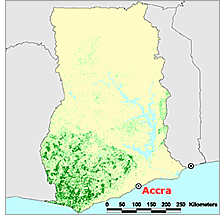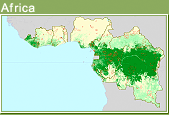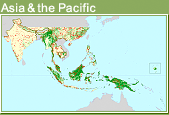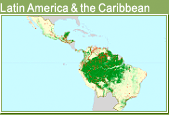Country details
Status of Tropical Forest Management 2005
Africa
Ghana

©UNEP-WCMC 2004
Ghana has favourable conditions for the achievement of SFM, such as impressive human resources – including a strong Forestry Commission – and a long history of forest management. Nevertheless, many challenges must be met. For example, fire plays an influential and – in some forests – destructive ecological role and is difficult to control. Some forest reserves are well-managed, but others may have been over-harvested and off-reserve forests are often unregulated. Moreover, illegal activities such as chainsaw lumber production and poaching are thought to be widespread.
Key points
- The area of PFE is an estimated 1.60 million hectares, comprising 1.15 million hectares of natural-forest production PFE, 353,000 hectares of protection PFE and 97,000 hectares of plantations.
- At least 270,000 hectares of natural-forest production PFE are considered to be managed sustainably; an estimated 108,000 hectares of protection PFE are so managed.
- The silvicultural system used in natural forests is a polycyclic selection felling system using a cutting cycle of 40 years; a national AAC has been set at 500,000 m3.
- There are manuals for production, management and planning, which set out the obligations of logging contractors.
- Ghana is establishing a sizeable plantation estate of teak.
- Community participation in forestry is being facilitated through community forest committees (CFCs) and a collaborative forest management unit of the Forestry Commission; in 2003 there were some 100 CFCs.
- An estimated 2 million people depend on forests for subsistence uses and traditional and customary lifestyles.
- Ghana has introduced a new timber utilization contract system to improve efficiency, transparency and accountability in forestry, particularly in forest production activities.
- There is limited information about the condition of protected areas.

 Africa
Africa  Asia & the Pacific
Asia & the Pacific  Latin America & the Caribbean
Latin America & the Caribbean